
Content
What is Beta Testing?
Beta testing is a type of external user acceptance testing and is the final round of testing performed before a product is finally released to the wider audience. In this testing, a nearly completed (90-95%) version of the software, known as the beta version is released to a limited number of end-users for testing. This beta testing method is performed to gain feedback on accessibility, usability, reliability, functionality, and other aspects of the developed software.

Typically, it is a testing process in which the real users use a minimal viable product in a production environment. The stakeholders of the beta test are the product management team, quality management team, and user experience team whereas the participants of beta testing are real users or end-users of the product.
What is the purpose of Beta Testing?

The main purpose of beta testing is to get the developed product tested by real users in the production environment. This method of beta testing is conducted to gain effective feedback for product improvement before launching the product into the market for a larger set of audience. Additionally, it is a known fact that continuous improvement is an ongoing process and continues with an aim to constantly evaluate and improve products over time.
As Beta testing is done by real-users or end-users, it gives more genuine and real-time insights about whether the product will be liked by end-users or not if launched. Moreover, beta testing also focuses on real-world compatibility of the product as the product is tested in the production environment on various OS, devices, platforms, browsers, etc.
Benefits of Beta Testing

● Beta testing delivers prompt feedback on the product and this helps to improve the product quality and thereby makes the product more satisfactory for the customer even before final release
● Beta testers test the reliability, usability, robustness of the software, and gives feedback/suggestions to developers to improve the product to meet customer expectations
● Beta testing helps various organizational teams to make informed decisions about a product depending on suggestions given by the testers who are the real-time users
● Helps to cover bugs in the software which might not have been covered or have been missed during any of the testing cycles
● Gives actual insight into customer likes and dislikes about the product since the product is tested by real users in a production environment
● Helps in improving the quality of software
● Customers feel valued and their opinion is considered for improving product quality, even in beta stage
● Reduces the product failure risk as the product is already tested before launching it to market
● Increases customer satisfaction as the product is improvised as per the beta testers suggestions
What are the Beta Version releases and Beta Testing types?
Types of beta version releases:
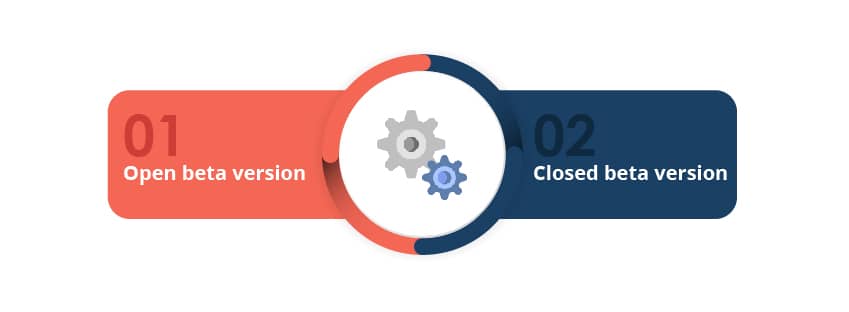
Open beta version:
Open beta version also known as the public beta version which is opened to all users. In this testing, any users can access the beta version of the product and can give their feedback and suggestions which can help developers to improve the product. Open beta test serves a dual purpose, as users can find and report any bugs in software along with suggestions for improvement. Simultaneously, it also helps testers and developers to validate the product in the production environment whether it meets the customer’s expectations.
Closed beta version:
Closed beta version is also known as the private beta version which is a beta version that is released to a specific or limited number of users. These users are either invited or selected by the organization itself. The beta testers of closed beta versions are either the existing customers of the organization, or will be the early adopters of the product or might also be paid beta testers.
Types of Beta Testing:
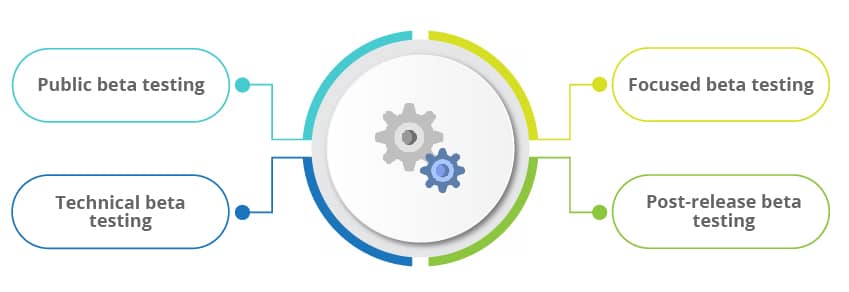
Public beta testing:
In this testing method, the software product is delivered to people worldwide via online channels, and the feedback from users is collected through the online channels only. Based on this feedback and data collected from users, the changes and modifications are made to the product so that it delivers a great experience to users.
Technical beta testing:
In this testing type, the software product is released to the internal employees or technical group of an organization to gather their feedback and suggestions for product improvement.
Focused beta testing:
Focused beta testing is performed to monitor specific features or components of the software product. In this testing, the software product is released to a group of people and their feedbacks and suggestions are collected for making improvements in the product.
Post-release beta testing:
In this testing type, the software product is released to the market for the end-users, and their feedback, suggestions, and data are collected for the future release of the software.
How to create a Beta Test Strategy?

Creating a beta test strategy is very important before conducting a beta test and a beta test strategy contains the below information:
● Business objective of the product
● Schedule for entire beta testing phases
● Beta test plan
● Beta testing approach to be followed by participants or beta testers
● Tools to be used for identification of bugs, measuring productivity, and for collecting feedback from end-users
● Rewards and incentives if any to the participants
● Information about entry and exit criteria
What are the steps involved in Beta Testing?
Let’s now understand the steps that are involved in performing a beta test:
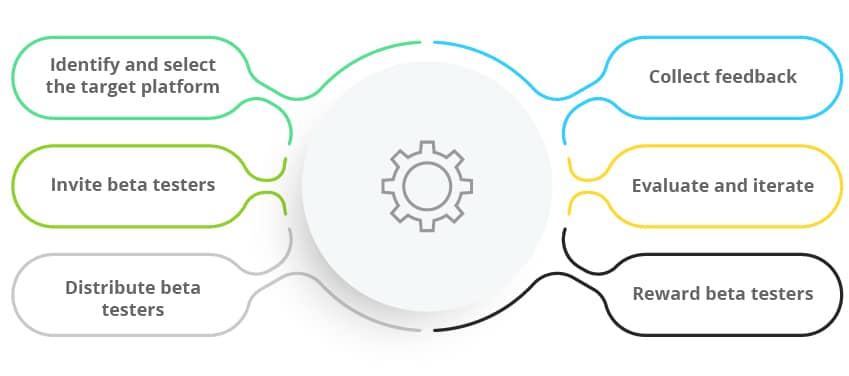
1. Identify and select the target platform:
Select the right platforms for which you want to test the software product. You have to choose from various OS and devices to get your product beta tested. Based on the product and its needs, you need to choose the testing platforms.
2. Invite beta testers:
Now comes the most crucial part, invite and carefully select your beta testers. Ideally, you should have 200-300 beta testers at the start so that you can get more feedback and suggestions for product improvement. You can invite beta testers from various sources – online and offline. Sources from where you can get beta testers are – websites, social media, Reddit, forums, directories, and personal contact, etc.
3. Distribute beta testers:
Now that you have a list of beta testers ready, it’s time to send them an invite by selecting the right distribution tool. You can select the tool that best suits your requirement. Some of the tools that you can use are Testflight, Google Play Developer Console, Crashlytics (Fabric), etc.
4. Collect feedback:
Now that end-users have tested your product, it’s time to take feedback from them. Feedbacks can either be positive or negative which typically depends on the experience beta testers have with your product.
5. Evaluate and iterate:
Based on the feedback and suggestions received from the participants, make iterations to your product so that it becomes ready for delivering the best user experience.
6. Reward beta testers:
Since testers have provided their valuable time and feedback, you should reward them with promised incentives. Rewards can be of various types such as coupons, discounts, promo codes, offers, etc.
Some of the ideal use cases of Beta Testing:
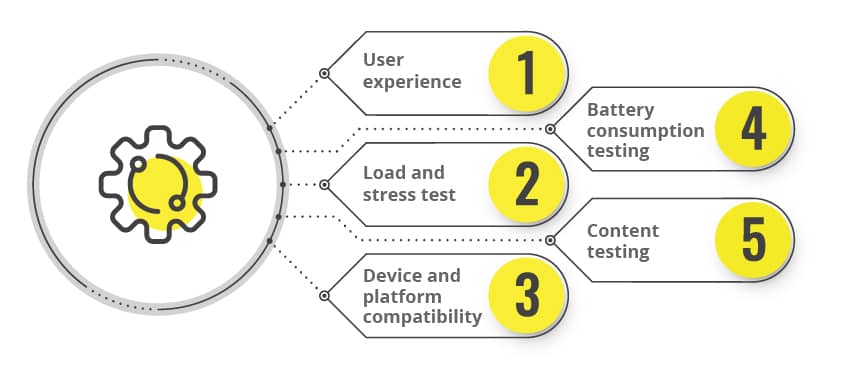
User experience:
Get an insight into your app’s performance in a real-environment to get a deep understanding of whether it is delivering a great experience to users by evaluating the feedback provided by real users or not
Load and stress test:
Test your apps with a large set of audience at the same time to check if any load handling issues are arising
Device and platform compatibility:
Test your apps on various devices and platforms to check their real-time compatibility
Battery consumption testing:
Get feedbacks from customers regarding batteries consumed by continuous usage of the application
Content testing:
Check if the content of your application such as photos, videos, texts, etc. are engaging the customer and ensure it is not hampering the overall user experience.
Alpha Testing Vs Beta Testing
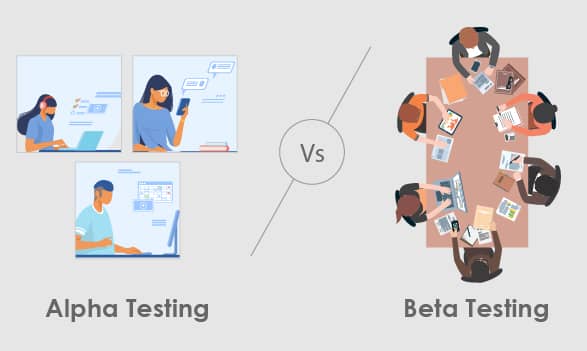
| Alpha Testing | Beta Testing |
|---|---|
| Alpha testing is performed by internal employees of the organization | Beta testing is done by real-users or end-users of the product who are not the employees of the organization |
| Alpha testing is performed at the developer’s site | Beta testing is done at the end users place or location |
| Developers are present during the alpha testing | Developers are not present during beta testing |
| Alpha testing is executed under a lab environment or testing environment | Beta testing is performed to check the software’s quality, reliability, usability, accessibility, etc. before moving it to the market or production environment and is performed after alpha testing |
| Alpha testing uses both black box and white box testing techniques | Beta testing uses a black-box testing technique |
| Alpha testing is usually conducted after the system testing phase and when the product is 70-90% complete | Beta testing is conducted after alpha testing and when the product is 90-95% complete |
| In Alpha testing each test cycle lasts for 1-2 weeks | In Beta testing, each test cycle lasts for 4-6 weeks |
Conclusion
Beta testing is an important software testing type that allows organizations to test their product with real users in a production environment before actually launching it in the market. The intensity of the beta testing can vary according to the product, but the main motive of beta testing remains to create a product that meets customer expectations and provides a great user experience.
Like every other testing method, beta testing has some challenges associated with it. Firstly, since beta testing has human involvement, it is more prone to human-errors. Also, the identification and selection of beta tester is not an easy task. Thus, it is advised to take help from an independent testing and QA services provider to get complete advantage. Leverage Beta testing from a next-gen software testing and QA services provider to achieve effective beta testing of your software. Talk to our experts.
Discover more
Get in Touch
Stay Updated
Subscribe for more info




